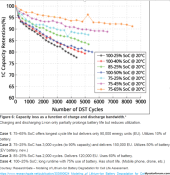sunshine_eggo
Happy Breffast!
So if that's true and you should only use the middle 60% of your lithiums
Then to me it almost seems like it's not worth paying out to go LiFePo4? You may aswell save a boat load of money and stick with lead acid at 50% usable capacity
As a big fan of FLA and AGM, I disagree.
50% DoD cycle life of quality AGM is about 1200
50% DoD cycle life of quality FLA maintained diligently is about 2000 cycles.
60-80% DoD cycle life of LFP is 6000+ cycles
How is lead advantageous with LFP delivering 4X the total energy over its life? QUALITY lead acid is going to run you > $150/kWh.




